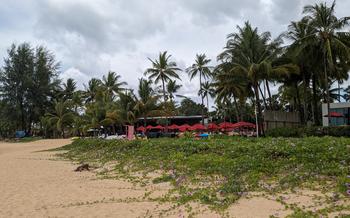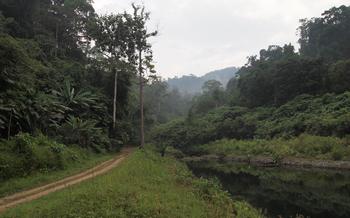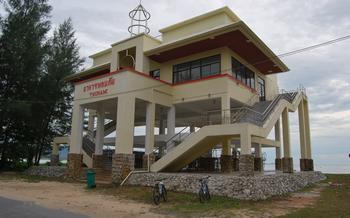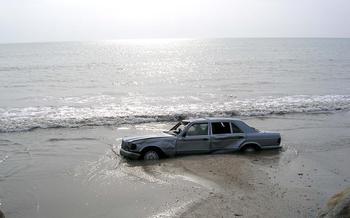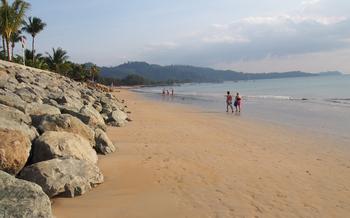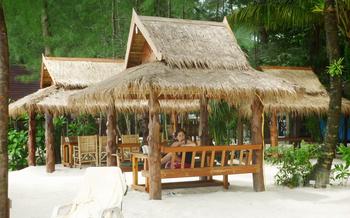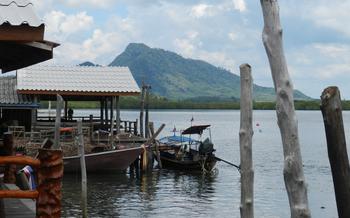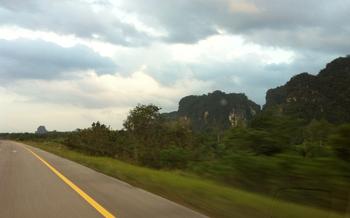
Thai Muang Turtle Sanctuary
- The Thai Muang Turtle Sanctuary: A Haven for Sea Turtles
- Educational Programs: Learning about Sea Turtles
- Turtle Watching: A Unique Experience
- Rehabilitation Center: Caring for Injured Turtles
- Hatchery: Witnessing New Life
- Egg Collection and Incubation Process
- Hatching Process
- Releasing Baby Turtles into the Sea
- Conservation Efforts: Protecting Sea Turtles
- Eco-Friendly Practices: Minimizing Impact
- Visitor Rules and Regulations: Ensuring Safety
- Dos and Don'ts for Visitors
- Safety Guidelines for Turtle Watching
- Respecting the Animals and Their Habitat
- Photography Tips: Capturing the Beauty
- Local Culture: Exploring the Surroundings
- Accommodation Options: Finding a Place to Stay
- Transportation: Getting to the Sanctuary
- From Phuket Airport
- From Krabi Airport
- Self-Driving Routes
- Food and Drinks: Dining Options
- Souvenirs: Supporting the Sanctuary
- Insider Tip: Hidden Gem Nearby
The Thai Muang Turtle Sanctuary: A Haven for Sea Turtles
History of the Sanctuary
The Thai Muang Turtle Sanctuary, located in Khao Lak, Thailand, holds a remarkable history dedicated to the conservation and protection of sea turtles. It all began in 1990 when a group of concerned locals, who witnessed the devastating impact of human activities on sea turtles, decided to establish a sanctuary to safeguard these gentle creatures.
Over the years, the sanctuary has grown from a small, grassroots initiative to a world-renowned center for sea turtle conservation. Through tireless efforts, the sanctuary has played a pivotal role in rehabilitating injured turtles, releasing hatchlings into the wild, and raising awareness about the importance of protecting these endangered species.
Types of Turtles Found Here
The Thai Muang Turtle Sanctuary provides a safe haven for a variety of sea turtle species, including the critically endangered Hawksbill turtle, the vulnerable Green turtle, and the endangered Loggerhead turtle. These magnificent creatures, known for their long migrations across oceans, find refuge within the sanctuary's protected waters, where they can feed, rest, and reproduce.
Importance of the Sanctuary for Conservation
The Thai Muang Turtle Sanctuary serves as a vital sanctuary for sea turtles, facing numerous threats in the wild, such as habitat loss, pollution, and illegal poaching. By providing a safe environment for turtles to thrive, the sanctuary contributes significantly to their conservation and helps ensure the survival of these ancient marine creatures.
Educational Programs: Learning about Sea Turtles
The Thai Muang Turtle Sanctuary offers a range of educational programs designed to teach visitors about the biology, behavior, and conservation of sea turtles. These programs are tailored to visitors of all ages and backgrounds, and provide a unique opportunity to learn more about these fascinating creatures.
Visitors can embark on guided tours of the sanctuary, led by knowledgeable and passionate guides who share insights into the sanctuary's work and the importance of sea turtle conservation. These tours cover topics such as sea turtle biology, nesting habits, and the threats they face. Visitors can also observe turtles up close in the sanctuary's tanks and enclosures, and learn about the rehabilitation process for injured turtles.
For those who want to get even more involved, the sanctuary offers volunteer opportunities that allow visitors to contribute directly to its conservation efforts. Volunteers can assist with tasks such as cleaning tanks, feeding turtles, and monitoring nests. This hands-on experience provides a deeper understanding of the sanctuary's work and the challenges faced by sea turtles in the wild.
Turtle Watching: A Unique Experience
If you're a nature enthusiast, then turtle watching at the Thai Muang Turtle Sanctuary is an experience not to be missed. These magnificent creatures can be observed in their natural habitat, providing an unforgettable encounter.
Best time to visit: The best time to visit the sanctuary for turtle watching is during the nesting season, which typically occurs from November to March. During this period, you're likely to witness turtles coming ashore to lay their eggs.
Tips for spotting turtles: To increase your chances of spotting turtles, it's important to be patient and observant. Look for signs of their presence, such as tracks in the sand or ripples in the water. Use a pair of binoculars or a telephoto lens to get a closer look without disturbing them.
Responsible turtle watching practices: When watching turtles, it's crucial to prioritize their well-being. Avoid using flash photography, as it can disorient them. Maintain a respectful distance and don't touch or disturb them. Remember, these animals are wild and should be treated with utmost respect.
Rehabilitation Center: Caring for Injured Turtles
The Thai Muang Turtle Sanctuary is not just a haven for healthy sea turtles; it also serves as a vital rehabilitation center for injured turtles that have been rescued from various threats. The dedicated team of veterinarians and marine biologists at the sanctuary works tirelessly to provide these injured turtles with the necessary care and treatment to give them a second chance at life.
The rehabilitation process begins with a thorough assessment of the turtle's condition. Based on the severity of the injuries, the turtles may require medical treatment, surgery, or long-term care. The team at the sanctuary is equipped with state-of-the-art facilities and expertise to handle a wide range of injuries, including shell damage, propeller wounds, fishing hook injuries, and entanglement in marine debris.
Injured turtles often arrive at the sanctuary in weak and malnourished condition. The rehabilitation process includes providing them with a nutritious diet and a controlled environment to rest and recover. The turtles are closely monitored by the sanctuary staff, who provide round-the-clock care to ensure their well-being.
Once the turtles have regained their strength and health, they are gradually introduced to a natural diet and prepared for release back into the ocean. The sanctuary team carefully assesses their readiness and only releases the turtles when they are confident that they have a good chance of survival in the wild.
The rehabilitation program at the Thai Muang Turtle Sanctuary has been instrumental in saving the lives of countless injured sea turtles, giving them a second chance to thrive in their natural habitat. These efforts play a crucial role in the conservation and protection of these magnificent marine creatures.
Hatchery: Witnessing New Life
Witnessing the miracle of life unfolding before your eyes is an experience that will stay with you forever. At the Thai Muang Turtle Sanctuary, the hatchery plays a crucial role in the conservation efforts of these remarkable creatures. Visitors are given the opportunity to witness the incredible journey of baby turtles, from their eggs to their first swim in the ocean.
Egg Collection and Incubation Process
The sanctuary collects eggs from safe and secure nesting sites along the coast. These eggs are then carefully placed in specially designed incubators, which simulate the natural conditions of a turtle nest. The temperature and humidity are closely monitored to ensure optimal conditions for the eggs to develop.
Hatching Process
The hatching process is a delicate and fascinating sight to behold. After approximately 50 to 60 days, the baby turtles, or hatchlings, begin to emerge from their eggs. They use their tiny flippers to break free from their shells and make their way to the surface of the sand.
Releasing Baby Turtles into the Sea
Once the hatchlings have fully emerged from their eggs, they are carefully collected and brought to the beach. Visitors are invited to participate in the release, gently placing the hatchlings in the sand near the water's edge. As the baby turtles make their way towards the ocean, their instinctual drive to return to their natural habitat is truly awe-inspiring.
Watching these tiny creatures navigate their way into the vast ocean is a deeply moving experience, reminding us of the importance of protecting these gentle giants and their fragile ecosystem.
Conservation Efforts: Protecting Sea Turtles
The Thai Muang Turtle Sanctuary is dedicated to protecting sea turtles and their habitats. The sanctuary's conservation efforts are crucial for ensuring the survival of these endangered species.
Threats to Sea Turtles:
-
Habitat Destruction: Coastal development and pollution destroy turtle nesting sites and feeding grounds.
-
Bycatch: Turtles are often caught in fishing nets as unintended bycatch, leading to injuries or death.
-
Illegal Trade: Turtles and their eggs are illegally traded for food, medicine, and other commercial purposes.
Conservation Measures Taken by the Sanctuary:
-
Habitat Conservation: The sanctuary works to protect and restore turtle nesting sites and feeding grounds.
-
Education and Awareness: The sanctuary raises awareness about sea turtle conservation through educational programs and outreach activities.
-
Anti-Poaching Patrols: The sanctuary conducts regular patrols to deter poaching and protect turtles from illegal trade.
Importance of Conservation for the Future:
-
Maintaining Biodiversity: Sea turtles play a vital role in marine ecosystems, helping maintain biodiversity and balance.
-
Promoting Sustainable Fisheries: By reducing bycatch, conservation efforts support sustainable fishing practices that protect both turtles and fisheries.
-
Ecotourism Potential: Responsible turtle watching can generate ecotourism revenue, benefiting local communities while promoting conservation.
Eco-Friendly Practices: Minimizing Impact
The Thai Muang Turtle Sanctuary is committed to minimizing its environmental footprint and promoting sustainable tourism practices. Visitors are encouraged to adopt eco-friendly habits to ensure the preservation of the natural habitat for sea turtles and other wildlife.
Reducing Plastic Waste:
-
Avoiding single-use plastics: Visitors should bring their own reusable water bottles and shopping bags to reduce plastic waste. Plastic straws and utensils should be declined when offered at local eateries.
-
Proper waste disposal: Trash bins are provided throughout the sanctuary. Visitors should dispose of their waste responsibly and avoid littering.
Respecting the Natural Environment:
-
Staying on designated paths: Visitors should remain on designated trails and avoid venturing into sensitive areas to minimize disturbance to wildlife and their habitats.
-
Refraining from feeding animals: Feeding wild animals can disrupt their natural behaviors and diets. Visitors should refrain from offering food to turtles or other wildlife.
-
Respecting nesting sites: Turtle nesting sites are marked with signs. Visitors should avoid disturbing these areas and maintain a respectful distance to ensure the turtles' safety.
Visitor Rules and Regulations: Ensuring Safety
To ensure the safety of both visitors and sea turtles, the Thai Muang Turtle Sanctuary has implemented a set of rules and regulations that all visitors must adhere to. These guidelines are designed to minimize disturbance to the turtles and their habitat, promoting responsible and ethical turtle watching practices.
Dos and Don'ts for Visitors
- Visitors are allowed to observe turtles from designated viewing platforms and walkways only.
- Do not enter the turtle enclosures or touch the turtles at any time.
- Do not feed the turtles. They have a specialized diet, and human food can be harmful.
- Do not use flash photography or bright lights, as these can disturb the turtles.
- Do not make loud noises or sudden movements that could startle the turtles.
- Do not litter or leave any trash behind. Keep the sanctuary clean and pristine.
Safety Guidelines for Turtle Watching
- Always wear appropriate footwear and clothing that you don't mind getting wet or sandy.
- Be aware of the tide times and weather conditions before venturing out.
- Do not swim or snorkel in the turtle sanctuary.
- Keep a safe distance from turtles and other marine life.
- If you spot a turtle in distress, immediately notify a staff member.
Respecting the Animals and Their Habitat
- Remember that the turtles are wild animals and should be treated with respect.
- Do not chase or harass the turtles.
- Do not attempt to handle or pick up the turtles.
- Observe the turtles from a distance and allow them to go about their natural behaviors undisturbed.
- Help protect the turtle's habitat by avoiding touching or damaging the coral reefs and marine plants.
By following these rules and regulations, visitors can help ensure the safety and well-being of the sea turtles, while also enjoying a rewarding and educational turtle-watching experience.
Photography Tips: Capturing the Beauty
The Thai Muang Turtle Sanctuary offers a rich opportunity for photographers to capture the beauty of sea turtles in their natural habitat. Here are some tips to help you take stunning photos:
-
Best Camera Settings: For optimal turtle photography, use a DSLR or mirrorless camera with a long lens (at least 200mm). Set your camera to aperture priority mode (Av or A) and choose a wide aperture (f/4 or wider) to blur the background and make the turtles stand out.
-
Ethical Photography Practices: Remember that turtles are wild animals and can be easily disturbed by human activity. Keep a respectful distance and avoid using flash photography, as it can harm their eyes.
-
Tips for Stunning Photos: To capture the best shots, position yourself low to the ground or in the water to get eye-level with the turtles. Be patient and wait for the turtles to come close before taking a photo. For underwater shots, use a waterproof camera or housing and adjust your settings accordingly.
Local Culture: Exploring the Surroundings
Khao Lak is a treasure trove of cultural experiences waiting to be discovered. Steeped in history, the region boasts ancient temples, traditional markets, and authentic Thai cuisine that will tantalize your taste buds.
History and Culture of Khao Lak: Khao Lak's rich history is intertwined with the sea. Once a thriving port town, it served as a crucial trading hub between Thailand and neighboring countries. Explore the captivating stories of the past at local museums, where you can learn about the area's maritime heritage, indigenous traditions, and the devastating impact of the 2004 tsunami.
Local Markets and Shops: Immerse yourself in the vibrant local markets, where you can haggle for souvenirs, handmade crafts, and fresh produce. From colorful textiles to intricate wood carvings, these markets offer a glimpse into the artistic talents of the local community. Take the opportunity to support local artisans and bring home unique mementos of your time in Khao Lak.
Traditional Thai Cuisine: Indulge in the tantalizing flavors of traditional Thai cuisine, known for its harmonious blend of sweet, sour, spicy, and salty. Sample the local delicacies, such as Khao Soi, a rich curry noodle soup, or Gaeng Daeng, a fiery red curry with bamboo shoots and Thai basil. For a refreshing treat, try the sweet and tangy Som Tum, a green papaya salad, or savor the aromatic Massaman Curry, a fragrant dish with tender beef and potatoes.
Accommodation Options: Finding a Place to Stay
The Thai Muang Turtle Sanctuary is located in a peaceful and serene area of Khao Lak, offering visitors a range of accommodation options to suit different budgets and preferences. For those seeking a budget-friendly stay, there are several guesthouses and hostels within walking distance of the sanctuary. These offer basic but comfortable rooms, often with shared bathrooms and common areas.
For a more luxurious experience, there are several resorts and hotels in the surrounding area. These offer a range of amenities, including private rooms, swimming pools, and restaurants. Some resorts also offer turtle-watching packages, which include guided tours of the sanctuary and opportunities to witness turtle releases.
Whether you choose a budget-friendly guesthouse or a luxurious resort, you'll find a welcoming and comfortable place to stay while visiting the Thai Muang Turtle Sanctuary.
Transportation: Getting to the Sanctuary
The Thai Muang Turtle Sanctuary is located in Khao Lak, a district in Phang Nga province, Thailand. It is approximately 60 kilometers north of Phuket International Airport (HKT) and 80 kilometers south of Krabi International Airport (KBV).
From Phuket Airport
- By taxi: The most convenient way to get to the sanctuary from Phuket Airport is by taxi. The journey takes about 1 hour and 15 minutes, and the fare should be around 1,500 Thai baht (THB).
- By bus: A more budget-friendly option is to take a bus from Phuket Airport to Khao Lak. The bus journey takes about 2 hours, and the fare is around 150 THB. From Khao Lak, you can take a taxi or tuk-tuk to the sanctuary.
From Krabi Airport
- By taxi: The journey from Krabi Airport to the Thai Muang Turtle Sanctuary takes about 1 hour and 30 minutes, and the fare should be around 2,000 THB.
- By bus: You can also take a bus from Krabi Airport to Khao Lak. The bus journey takes about 2 hours and 30 minutes, and the fare is around 200 THB. From Khao Lak, you can take a taxi or tuk-tuk to the sanctuary.
Self-Driving Routes
If you are renting a car, you can drive to the Thai Muang Turtle Sanctuary from either Phuket or Krabi. The journey from Phuket takes about 1 hour and 15 minutes, and the journey from Krabi takes about 1 hour and 30 minutes.
The sanctuary is located on the main road between Phuket and Krabi, and it is well-signposted. There is ample parking available at the sanctuary.
Food and Drinks: Dining Options
Khao Lak offers a diverse range of dining options, from local Thai restaurants to international cuisines. For an authentic Thai experience, head to the local markets or street food stalls, where you can savor delicious and affordable dishes like pad thai, tom yum goon, and som tam. Sample fresh seafood caught from the Andaman Sea and indulge in local delicacies like grilled prawns and coconut-infused curries. Many restaurants offer scenic views of the surrounding mountains and beaches, making your dining experience even more enjoyable.
If you're looking for a fine-dining experience, Khao Lak has several upscale restaurants offering a blend of Thai and international flavors. These restaurants often feature unique culinary creations and a sophisticated ambiance. For a truly memorable meal, consider booking a table at a beachfront restaurant and savor your food while enjoying the sunset over the shimmering Andaman Sea.
For vegetarians and vegans, Khao Lak has a growing number of restaurants that cater to your dietary needs. Many Thai dishes can be easily adapted to exclude meat, and there are also several dedicated vegetarian and vegan restaurants offering a variety of delicious options. Be sure to try the local vegetable curries, tofu stir-fries, and fresh fruit shakes.
Souvenirs: Supporting the Sanctuary
The Thai Muang Turtle Sanctuary offers a unique opportunity to purchase souvenirs that not only commemorate your visit but also support its conservation efforts. The sanctuary has a gift shop where visitors can find a variety of turtle-themed merchandise, including T-shirts, hats, plush toys, and jewelry. These items are not only a great way to remember your time at the sanctuary but also help to raise funds for its ongoing conservation work.
In addition to the turtle-themed merchandise, the gift shop also sells a variety of handicrafts made by local artisans. These handicrafts are a great way to support the local economy and promote traditional Thai culture. The proceeds from the sale of these handicrafts also go to support the sanctuary's conservation efforts.
By purchasing souvenirs from the Thai Muang Turtle Sanctuary, you can help to support its vital conservation work and ensure that sea turtles continue to thrive in the wild.
Insider Tip: Hidden Gem Nearby
While visiting the Thai Muang Turtle Sanctuary, take the time to explore the nearby Tsunami Memorial Park, a poignant tribute to the victims of the devastating 2004 Indian Ocean tsunami. Situated just a short drive from the sanctuary, this serene memorial park offers a space for reflection and remembrance.
Stroll through the park's tranquil gardens, lined with commemorative plaques bearing the names of those who lost their lives. Pay your respects at the central monument, a towering wave-shaped structure symbolizing the immense power of the tsunami. The park also features an informative museum that chronicles the events of that fateful day and the subsequent relief efforts.
Visiting the Tsunami Memorial Park is a sobering but important experience, providing a deeper understanding of the impact of the tsunami on the local community and the resilience of the human spirit. It serves as a reminder of the fragility of life and the importance of cherishing every moment.
